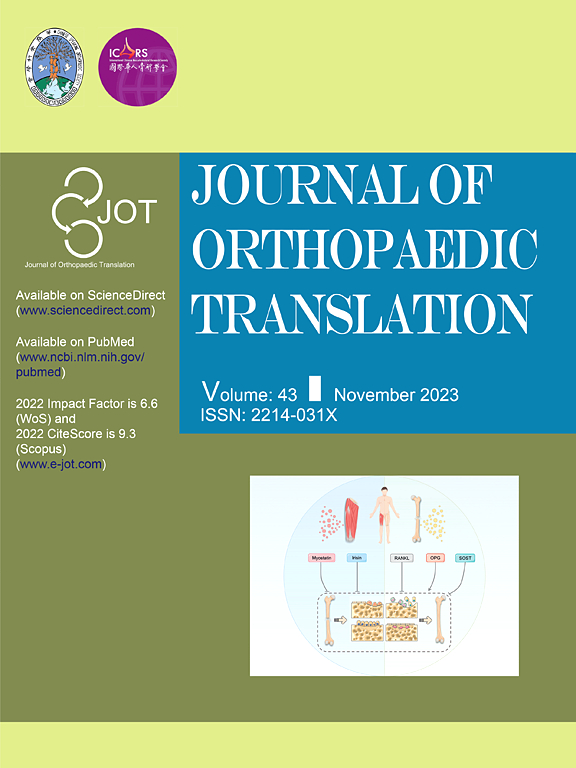具有协同抗菌和促进骨整合特性的近红外智能响应骨科植入物
IF 5.9
1区 医学
Q1 ORTHOPEDICS
引用次数: 0
摘要
抗生素使用的减少使得种植体后感染的治疗越来越具有挑战性,特别是在种植体早期由于组织与种植体融合不足而引起的细菌入侵问题。通过协同作用开发多种方法来减少细菌感染将优于单一模式的抗菌手段。方法采用磷酸钛(TiP)/氧化铜纳米颗粒(CuO)/纳米羟基磷灰石(n-HA)复合涂层TiP-ua,通过光热治疗(PTT)和光动力治疗(PDT)协同作用,在近红外(NIR)照射下杀灭金黄色葡萄球菌(S. aureus)和大肠杆菌(E. coli)。结果在0.9 W/cm2功率980 nm近红外光照射15 min后,TiP-ua复合涂层温度可达60℃左右,产生一定量的活性氧。在0.9 W/cm2功率近红外照射10 min下,复合涂层对金黄色葡萄球菌的杀伤效果可达90%左右,对大肠杆菌的杀伤效果可达90%以上。在小鼠成骨前细胞(MC3T3-E1)中,TiP-ua在促进成骨分化能力方面更有优势。在小鼠感染模型中也表现出良好的抗菌作用,并能显著降低炎症因子的表达,加速伤口愈合。在骨缺损模型中,干预显著加速了新生骨组织的再生,增强了骨整合能力。结论实验结果表明,TiP-ua涂层不仅具有良好的光热转换能力,而且具有良好的生物安全性,可以加速种植体周围骨组织的再生和修复,包括加速细胞的成骨分化,降低细菌的活性,有效减轻炎症反应。本研究的协同抗菌骨修复涂层制备工艺简单,重复性高,生物安全性高,对骨组织修复有积极作用,在骨科和牙种植体方面具有很大的临床应用潜力。本文章由计算机程序翻译,如有差异,请以英文原文为准。

Near-infrared smart responsive orthopedic implants with synergistic antimicrobial and bone integration-promoting properties
Background
The decline in antibiotic use has made the treatment of post-implant infections increasingly challenging, especially the problem of bacterial invasion caused by inadequate tissue fusion with the implant in the early stages of the implant. Developing multiple methods to reduce bacterial infections through synergies will be superior to a single model of antimicrobial means.
Methods
The composite coating composed of titanium phosphate (TiP)/copper oxide nanoparticles (CuO)/nano-hydroxyapatite (n-HA) named TiP-ua was used to kill Staphylococcus aureus (S. aureus) and Escherichia coli (E. coli) under near infrared (NIR) irradiation by means of photothermal therapy (PTT) and photodynamic therapy (PDT) synergism.
Results
The TiP-ua composite coating can reach about 60 °C and produce a certain amount of reactive oxygen species after 15 min irradiation with 980 nm near infrared light with 0.9 W/cm2 power. Under the NIR irradiation of 0.9 W/cm2 power for 10 min, the composite coating can achieve about 90% killing effect on S. aureus and more than 90% killing effect on E. coli. In terms of mouse pre-osteoblasts (MC3T3-E1), TiP-ua showed more superiority in promoting osteogenic differentiation ability. In the mouse infection model, it also showed good antibacterial effect, and could significantly reduce the expression of inflammatory factors and accelerate wound healing. In the bone defect model, the intervention significantly accelerated the regeneration of neobone tissue and enhanced osseointegration capacity.
Conclusions
The experimental results show that TiP-ua coating not only has good photothermal conversion ability, but also has good biosafety, which can accelerate the regeneration and repair of bone tissue around the implant, including accelerating the osteogenic differentiation of cells, and reduce the activity of bacteria to effectively reduce the inflammatory response.
The translational potential of this article
The collaborative antibacterial and bone repair coating in this study has a simple preparation process, high repeatability, high biosafety and positive effect on bone tissue repair, and has great clinical application potential in orthopedics and dental implants.
求助全文
通过发布文献求助,成功后即可免费获取论文全文。
去求助
来源期刊

Journal of Orthopaedic Translation
Medicine-Orthopedics and Sports Medicine
CiteScore
11.80
自引率
13.60%
发文量
91
审稿时长
29 days
期刊介绍:
The Journal of Orthopaedic Translation (JOT) is the official peer-reviewed, open access journal of the Chinese Speaking Orthopaedic Society (CSOS) and the International Chinese Musculoskeletal Research Society (ICMRS). It is published quarterly, in January, April, July and October, by Elsevier.
 求助内容:
求助内容: 应助结果提醒方式:
应助结果提醒方式:


